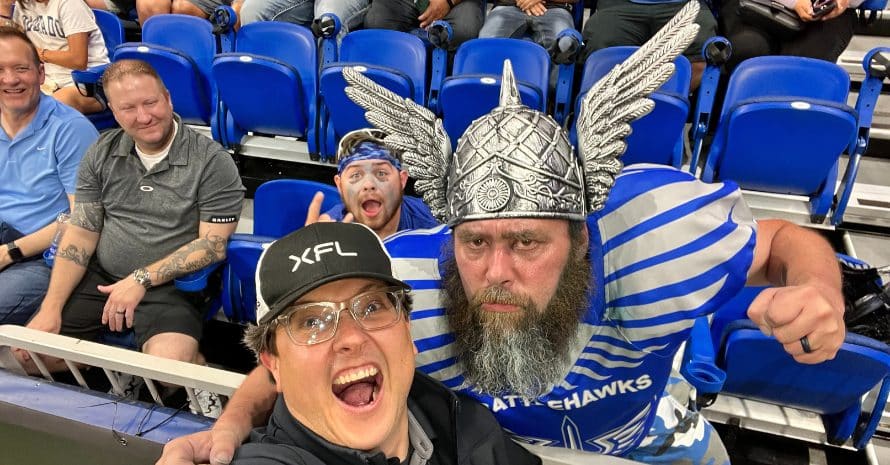X’S AND O’S: Sports architect Chris Lamberth mugs with St. Louis Battlehawks super fan Ted Ricci at the Alamodome, site of the XFL championship game on May 13. (Chris Lamberth)
New job covers PACs, convention centers
Sports architect Chris Lamberth, among the most well-connected professionals in the industry, has returned to HKS as a principal, responsible for global venues business strategy across multiple disciplines.
His first day back at the firm was May 9.
Lamberth, 53, has more than 25 years of experience in architecture. Early in his career, he worked at HKS from 2001-2004, helping design upgrades to ballparks for the Texas Rangers and Chicago White Sox.
From there, he spent the next 15 years with renowned sports designers George Heinlein, Brad Schrock and Tracy Stearns as they started their own practice, which evolved into 360 Architecture, before it was sold to HOK in 2015. Lamberth worked in business development for a company that designed MetLife Stadium, Mercedes-Benz Stadium and major renovations to Hard Rock Stadium, among other high-profile projects.
Most recently, Lamberth was employed with TVS to help launch its sports practice in Atlanta. After four years with TVS, the two parted ways in February and Lamberth spent the past three months working for the XFL in football operations with stadium management veterans Tony Pereira and Troy Brown.
At HKS, Lamberth will lead business strategy for sports, convention centers, performing arts centers and aviation. He returns to his roots in a sense, re-teaming with Mark Williams, an executive vice president and architect with the company for 27 years. Lamberth’s position is essentially an extension of the role Williams has filled for many years with a little bit of customization across other design sectors.
“Chris cut his teeth at HKS, then left and had a successful run,” Williams said. “We want to focus his efforts. We spend a lot of time thinking about our next clients and aligning them with our visions and we want Chris to do the same thing and elevate business for us. Everybody I know, knows Chris and a lot of people I don’t know, know Chris. We want to take the time to filter the next steps for our group. It’s an exciting thing.”
Lamberth remains in Los Angeles, where he’s lived for 34 years and graduated from Cal State-Fullerton with a bachelor’s degree in architectural engineering. HKS has a strong presence in the market with SoFi Stadium among its signature projects. Lance Evans, part of the firm’s leadership team, was lead architect for the two-team NFL venue and is based in LA.
The HKS venues group is headquartered in Dallas, and also has offices in New York, Atlanta, Georgia, Salt Lake City, Utah and Richmond, Virginia, plus London, England.
It was at SoFi Stadium that Lamberth reconnected with Williams a few months ago during a stadium tour with some structural engineers, setting the wheels in motion about the possibility of reuniting at HKS. In addition, Lamberth kept running into Evans at SoFi events in Inglewood.
The homecoming in a sense continued during Lamberth’s interview in February with HKS officials at their home office in Dallas. There were 10 people at the table, and seven of them had worked with Lamberth on previous projects, he said.
Over the past two years, HKS has gone through a transition process after Bryan Trubey, who founded the firm’s sports practice in 1992, left the company and eventually landed at Overland Partners. About a dozen people followed Trubey out the door and joined Overland.
Williams assumed Trubey’s position as the senior leader of the HKS sports group.
“Mark has always been the cleaner and the fixer at the firm; he has a great temperament,” Lamberth said. “HKS has an established office in LA with a large sports practice. There’s things we can do better and that’s what Mark is doing. Sports probably needs the least amount of attention, but it’s about maintaining relationships with these clients that we’ve had for years. It keeps us out there in the community and helps us build internally with good architects.”
In his new role, Lamberth said he will spend the second half of this year to re-assess where HKS stands with its strengths and weaknesses in the ultra-competitive world of public assembly development before forming a plan of action for 2024.
“The biggest challenge for me is it’s not all sports; we’ve got to reassess the convention centers and performing arts practices,” Lamberth said. “It’s a big company, and coming out of COVID, people are getting crazy money to go work with our competitors and vice versa. It’s still a business and there is still a question of whether a recession will hit us. That’s why I’m looking cautiously at 2023 and preparing for 2024 is a good strategy.”
As part of that reassessment, Lamberth will lean on the experience he gained from Heinlein, Schrock and Trubey, among others, as well as his short stint in the XFL, where he performed some less glorious tasks at dated facilities such as Cashman Field in Las Vegas, home of the league’s Vegas Vipers.
“If anything, I learned to listen, and most important, that no job is beneath me,” Lamberth said. “I had to plunge toilets once before halftime, because there was no other staff to do it. I was a glorified Bobby Boucher with the XFL, but if you don’t ever experience how they load equipment into the stadium (among other logistics), how am I supposed to design it with some authority? It helped me where I was weak, on the football side, and adds to what I already know.”







